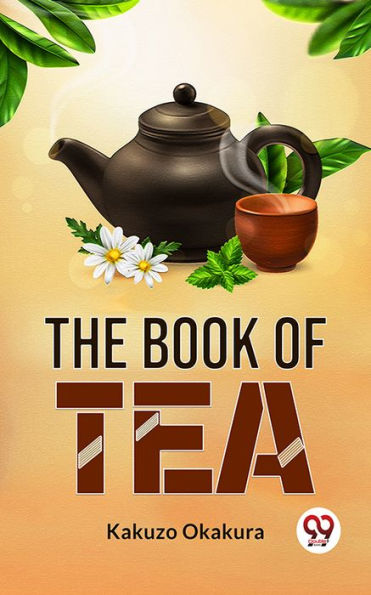5
1


eBook
$0.99
Available on Compatible NOOK devices, the free NOOK App and in My Digital Library.
WANT A NOOK?
Explore Now
Related collections and offers
0.99
In Stock
Overview
The Book of Tea' is a philosophical treatise written by Kakuzo Okakura, a Japanese scholar, art critic, and curator, first published in 1906. This influential work explores the aesthetics, cultural significance, and philosophy behind the Japanese tea ceremony. The author discusses the principles of simplicity, harmony, and reverence that are central to the tea ceremony, highlighting its ability to foster a deeper connection with nature, oneself, and others. Okakura explores the contrast between Eastern and Western cultures, examining how the appreciation of tea reflects differing approaches to beauty, spirituality, and the pursuit of knowledge. He emphasizes the importance of preserving traditional values and aesthetics in the face of modernization. It provides readers with a profound understanding of the philosophy and artistry underlying the tea ceremony, making it a cherished text for those interested in Japanese culture, aesthetics, and the pursuit of a mindful existence.

Product Details
| ISBN-13: | 9789358594317 |
|---|---|
| Publisher: | Double 9 Books |
| Publication date: | 07/01/2023 |
| Sold by: | Barnes & Noble |
| Format: | eBook |
| File size: | 527 KB |
About the Author
Okakura Kakuz, also known as Okakura Tenshin, was a Japanese academic and art critic who, during the Meiji Restoration reform era, defended conventional forms, practices, and beliefs. He lived from February 14, 1863, to September 2, 1913. He is most known outside of Japan for his 1906 book The Book of Tea: A Japanese Harmony of Art, Culture, and the Simple Life. It was written in English after the Russo-Japanese War, denounced Western stereotypes of Asians in general and the Japanese specifically, and voiced the worry that Japan would only acquire respect to the extent that it copied the barbaric practices of Western militarism. On the eve of the Russo-Japanese War, he released The Ideals of the East with Special Reference to the Art of Japan, a book on Asian aesthetic and cultural history. It is famous for its opening paragraph, which asserts that Asia differs from the West because of its spiritual unity. When Kakuzo persisted in visiting his mountain estate in Akakura in August 1913, his sister, wife, and daughter eventually transported him there by train. Kakuzo was able to communicate with others and feel a little better for almost a week before suffering a heart attack on August 25.
Table of Contents
The Cup of Humanity 1
Tea ennobled into Teaism, a religion of aestheticism, the adoration of the beautiful among everyday facts
Teaism developed among both nobles and peasants
The mutual misunderstanding of the New World and the Old
The Worship of Tea in the West
Early records of Tea in European writing
The Taoists' version of the combat between Spirit and Matter
The modern struggle for wealth and power
The Schools of Tea 17
The three stages of the evolution of Tea
The Boiled Tea, the Whipped Tea, and the Steeped Tea, representative of the Tang, the Sung, and the Ming dynasties of China
Luwuh, the first apostle of Tea
The Tea-ideals of the three dynasties
To the latter-day Chinese Tea is a delicious beverage, but not an ideal
In Japan Tea is a religion of the art of life
Taoism and Zennism 33
The connection of Zennism with Tea
Taoism, and its successor Zennism, represent the individualistic trend of the Southern Chinese mind
Taoism accepts the mundane and tries to find beauty in our world of woe and worry
Zennism emphasizes the teachings of Taoism
Through consecrated meditation may be attained supreme self-realisation
Zennism, like Taoism, is the worship of Relativity
Ideal of Teaism a result of the Zen conception of greatness in the smallest incidents of life
Taoism furnished the basis for aesthetic ideals, Zennism made them practical
The Tea-Room 51
The tea-room does not pretend to be other than a mere cottage
The simplicity and purism of the tea-room
Symbolism in the construction of thetea-room
The system of its decoration
A sanctuary from the vexations of the outer world
Art Appreciation 73
Sympathetic communion of minds necessary for art appreciation
The secret understanding between the master and ourselves
The value of suggestion
Art is of value only to the extent that it speaks to us
No real feeling in much of the apparent enthusiasm to-day
Confusion of art with archaeology
We are destroying art in destroying the beautiful in life
Flowers 87
Flowers our constant friends
The Master of Flowers
The waste of Flowers among Western communities
The art of floriculture in the East
The Tea-Masters and the Cult of Flowers
The Art of Flower Arrangement
The adoration of the Flower for its own sake
The Flower-Masters
Two main branches of the schools of Flower Arrangement, the Formalistic and the Naturalesque
Tea-Masters 107
Real appreciation of art only possible to those who make of it a living influence
Contributions of the Tea-Masters to art
Their influence on the conduct of life
The Last Tea of Rikiu
From the B&N Reads Blog
Page 1 of
